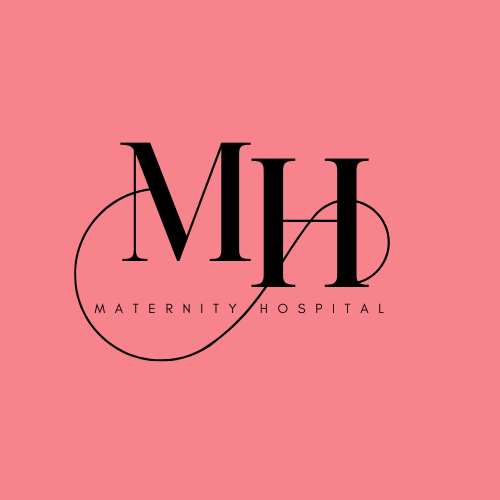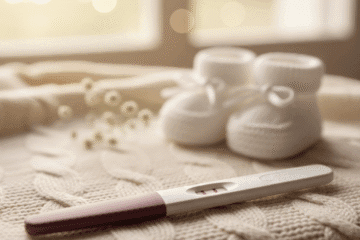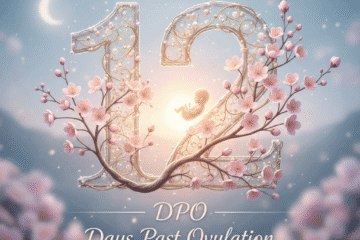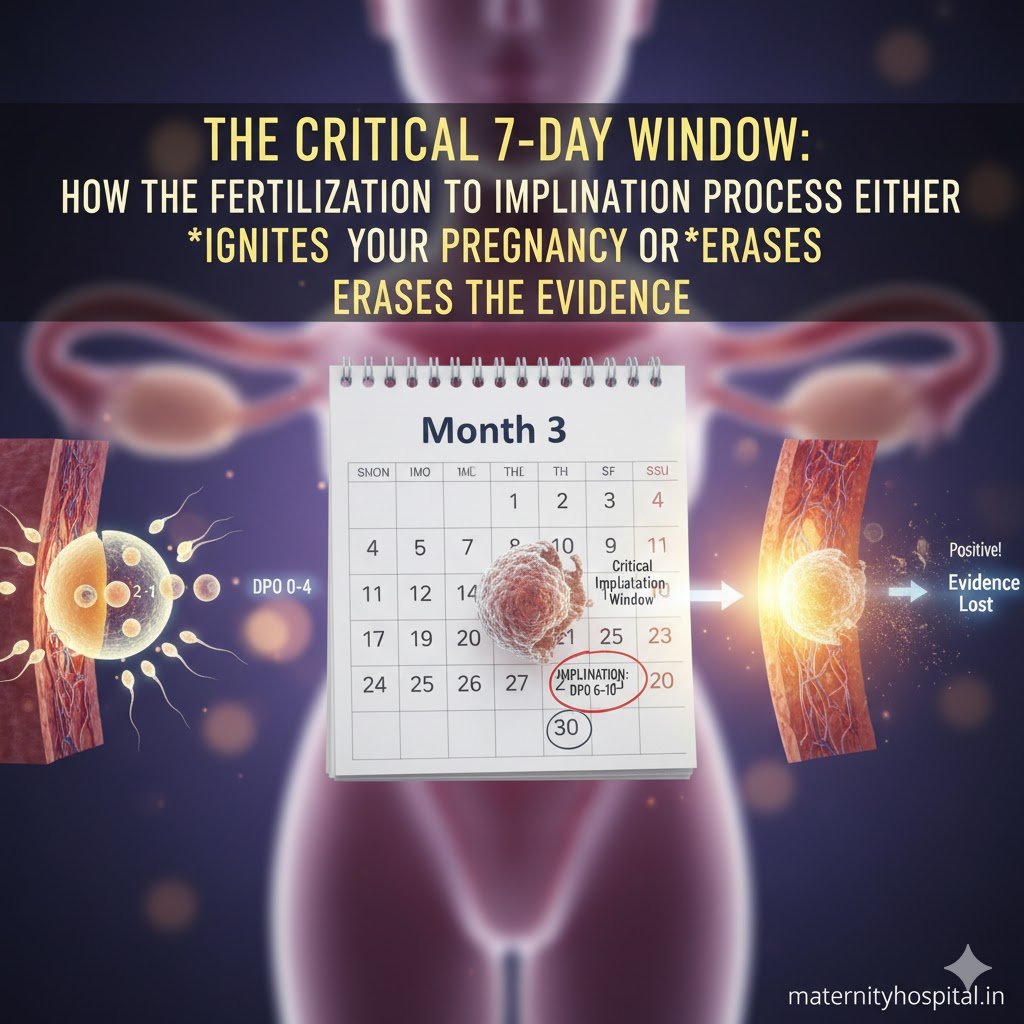
The CRITICAL 7-Day Window: How the Fertilization to Implantation Process happens.
The Microscopic Miracle:A Day-by-Day Guide to the Fertilization to Implantation Process
The two-week wait is often called the “black box” of conception—a period shrouded in mystery where women are left guessing and symptom-spotting. For those trying to conceive (TTC), understanding the precise steps of this biological ballet can transform anxiety into informed anticipation.
The journey from a single sperm meeting an egg to the embryo anchoring in the womb is one of nature’s greatest achievements. This comprehensive guide lifts the curtain, detailing the precise sequence and timing of the fertilization to implantation process, providing a day-by-day account of the critical events that turn a hopeful cycle into a confirmed pregnancy.
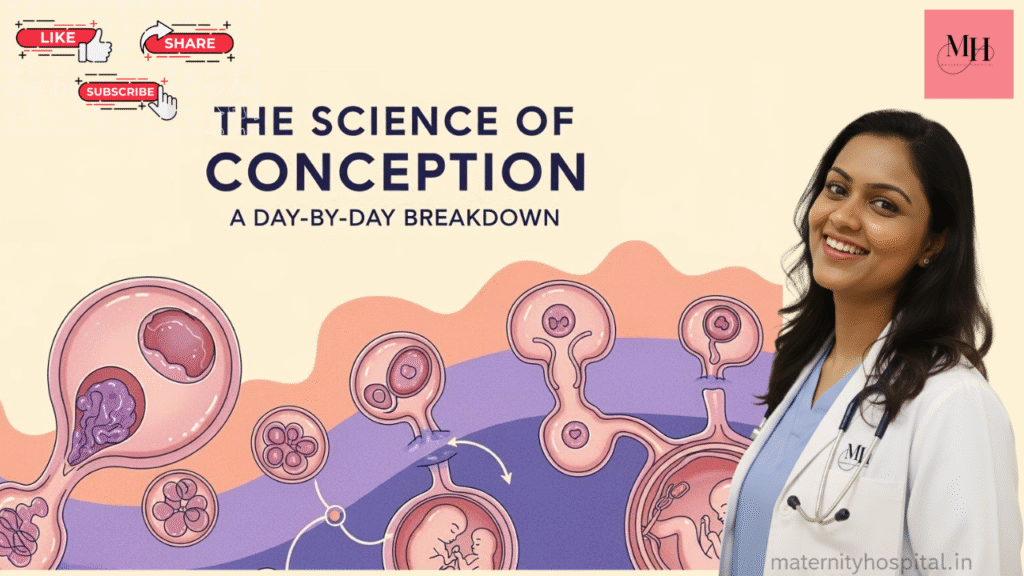
Day 0 – The Commencement of the Process
The cycle’s main event—ovulation—sets the stage, but the fertilization to implantation process truly begins with the single, successful fusion of genetic material.
Ovulation and The Sperm’s Race (Day 0)
- The Clock Starts: The mature egg is released from the ovary and swept into the fallopian tube. It has a mere 12 to 24 hours to be fertilized.
- The Meeting Point: Millions of sperm start the marathon, but only a few hundred will reach the ampulla—the outer third of the fallopian tube—where the egg waits.
- Fertilization: When one sperm successfully penetrates the egg, a change occurs on the egg’s surface, preventing any other sperm from entering. The genetic material merges, forming a single-celled organism called the zygote.
Progesterone Takes Over
The ruptured follicle on the ovary instantly transforms into the corpus luteum, which immediately begins flooding the body with progesterone. This is the key hormone responsible for preparing and stabilizing the uterine lining for the successful completion of the fertilization to implantation process. Any physical symptoms felt immediately after ovulation (sore breasts, fatigue) are primarily the work of this progesterone surge.
Days 1–5 –The Embryo's Cellular Transformation
The zygote spends its first five days journeying down the fallopian tube, undergoing rapid and precise cell division. This microscopic journey is an essential prelude to anchoring in the uterus.
Exponential Division: Cleavage
The zygote doesn’t grow in overall size during these first few days; instead, it partitions its cytoplasm, increasing the number of cells within its protective outer shell (zona pellucida).
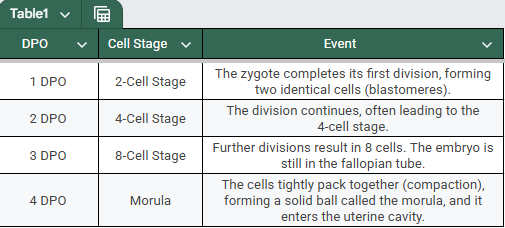
The Blastocyst Milestone (Day 5)
This is a major achievement in the fertilization to implantation process. The morula reorganizes, creating a fluid-filled cavity and differentiating into two distinct cell types:
- Inner Cell Mass (ICM): The core group of cells that will become the fetus.
- Trophoblast: The outer layer of cells that will form the placenta and anchor the embryo.
This sophisticated structure—the blastocyst—is now ready to attempt implantation.
Days 6–10 –The Implantation Window
The embryo must successfully adhere and integrate into the uterine lining during this narrow window of time (Days 6–10 DPO). Failure here is the most common reason for a cycle not resulting in a pregnancy.
Day 6: The Hatching Requirement
The blastocyst must physically break free, or hatch, from its zona pellucida shell. It cannot interact with the uterine lining while encased. Once free, the exposed trophoblast cells initiate chemical communication with the endometrium.
Day 7–8: Adhesion and Invasion
- Adhesion: The trophoblast cells find a suitable spot on the uterine wall and begin to “stick,” or adhere, to the prepared lining.
- Invasion (Implantation): The cells actively burrow deep into the maternal tissue, integrating with the blood vessels. This anchors the embryo and officially establishes the start of a clinical pregnancy.
- The First Hormone: As implantation completes, the newly integrated placental tissue begins to release Human Chorionic Gonadotropin (hCG). This hormone is the definitive chemical signal confirming the success of the fertilization to implantation process.
Day 9–10: The Corpus Luteum Rescue
The rising hCG now takes on a critical, life-sustaining role. It signals the corpus luteum on the ovary to continue producing progesterone. This progesterone surge sustains the uterine lining and prevents the onset of menstruation. This hormone feedback loop is the final, non-negotiable step in the fertilization to implantation process for a viable pregnancy.
The Human Touch: If you experience any light pink or brown spotting during this period, it could be “implantation bleeding,” caused by the embryo’s invasion of the uterine blood vessels. However, its absence is entirely normal—most successful implantations occur without any spotting.
Days 11–14 –Confirmation and Moving Forward
The final stage of the two-week wait involves waiting for the hCG levels to rise to a detectable point.
Day 11–12: Early Detection Threshold
- Hormone Doubling: HCG levels double roughly every 48 hours. By Day 12, a highly sensitive home pregnancy test (HPT) is often capable of detecting the hormone.
- Symptom Shift: Any new symptoms (such as nausea or increased urgency to urinate) that appear during this time are likely driven by the rapidly increasing hCG, whereas earlier symptoms were primarily progesterone-based.
Day 13–14: The Final Confirmation
If menstruation has not occurred by Day 14, the pregnancy is biologically established. A positive HPT at this stage is virtually guaranteed.
The Human Touch: Remember that the success rate in any given cycle, even with optimal timing, is only about 20-25%. If your cycle does not result in a positive test, it most often means the embryo was non-viable, or the fragile connection required during the fertilization to implantation process was not fully established. A negative outcome is a biological event, not a failure.
FAQ'sFrequently Asked Questions
Q1. What is the difference between fertilization and implantation?
Fertilization is the union of the sperm and the egg, which typically happens within 12–24 hours after ovulation in the fallopian tube (Day 0). Implantation is the process where the fertilized egg (now a blastocyst) anchors itself into the uterine lining (endometrium), which occurs much later, primarily between Days 6 and 10 after ovulation. Implantation is the event that officially establishes a clinical pregnancy and triggers the release of hCG.
Q2. How long does the entire fertilization to implantation process take?
The entire process takes approximately 6 to 10 days.
- Fertilization (Day 0): Immediate (within 24 hours of ovulation).
- Travel and Cell Division (Days 1–5): The embryo travels down the fallopian tube into the uterus.
- Implantation (Days 6–10): The blastocyst attaches to and burrows into the uterine wall.
Q3. Why is the time between 6 and 10 DPO considered the “critical window”?
This is the implantation window, the only time in the cycle when the uterine lining is hormonally and structurally receptive enough to allow the blastocyst to anchor. If the embryo is too early or too late, or if the process of adhesion and invasion is flawed, implantation fails, and the cycle results in menstruation.
Q4. If I feel symptoms right after ovulation (like sore breasts), does that mean I’m pregnant?
Not definitively. Symptoms like sore breasts, fatigue, and mild cramping immediately after ovulation (DPO 1–5) are caused almost entirely by the massive surge of progesterone released by the corpus luteum. These symptoms occur regardless of whether fertilization or successful implantation has taken place, making them an unreliable early indicator of pregnancy.
Q5. What is the “hatching” of the blastocyst, and why is it important?
Hatching is the crucial step (around Day 6) where the blastocyst breaks out of its protective outer shell, the zona pellucida. This step is necessary because the outer layer of the embryo (the trophoblast) must make direct physical contact with the uterine wall to begin the adhesion and invasion phases of the fertilization to implantation process.
Q6. Is “implantation bleeding” a reliable sign of a successful cycle?
No. Implantation bleeding (light spotting that occurs around 7–10 DPO) is experienced by only a small fraction of women (estimates vary, but often cited as $15-25\%$). While it can signal that the embryo has successfully burrowed into the uterine blood vessels, most successful implantations occur without any noticeable spotting. Its absence should not be taken as a negative sign.
Q7. When does the body start producing the hCG hormone, and when can I test?
The body begins producing hCG as soon as implantation is complete, typically around Day 8 or 9 DPO.
- Earliest Testing: You may get a faint positive on a highly sensitive test around 10 DPO.
- Most Reliable Testing: Testing should ideally be done on or after 14 DPO (the day of the expected period) when hCG levels are high enough for accurate detection.
Conclusion:The Ultimate Biological Achievement
The 14-day timeline from ovulation to a missed period is anything but passive. It is a period defined by the successful completion of the fertilization to implantation process—a demanding sequence that requires perfection from the egg, the sperm, the uterine lining, and the hormonal system.
By understanding this incredible day-by-day guide, you are empowered to navigate the two-week wait with scientific insight, recognizing the immense biological achievement that is the fertilization to implantation process. This knowledge replaces the ambiguity of symptom-spotting with an appreciation for the precision of the microscopic miracle unfolding within.
| National Institute of Child Health and Human Development (NICHD) on the First Trimester | https://www.nichd.nih.gov/health/topics/factsheets/pregnancy | Place in the conclusion or the final part (Part IV) when discussing the confirmation of pregnancy and the subsequent first trimester. |
| Mayo Clinic’s guide to the fertilization and implantation process | https://www.mayoclinic.org/healthy-lifestyle/pregnancy-week-by-week/multimedia/fertilization-and-implantation/img-20008656 | Place in Part II (Days 1-5) when detailing the cellular division stages (Zygote, Morula, Blastocyst). |
| Cleveland Clinic’s general overview of conception | https://my.clevelandclinic.org/health/articles/11585-conception | Place in the introduction or Part I (Day 0) when establishing the basic science of the sperm-egg union and the start of the process. |
| CDC guidance on preparing for pregnancy (Preconception Care) | https://www.cdc.gov/pregnancy/index.html | Place in the introductory section or a call-out box recommending preparation before even attempting the fertilization to implantation process. |
